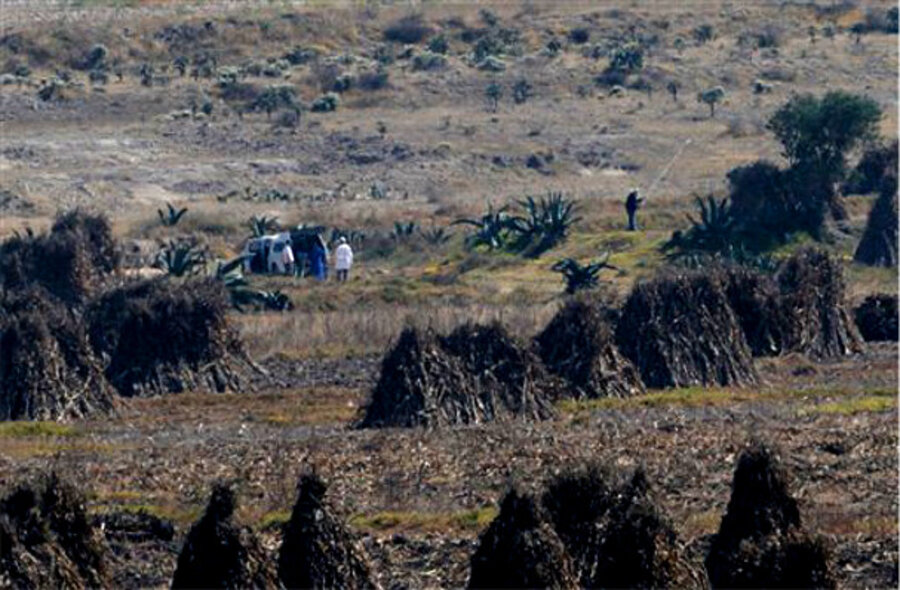Mexico's dilemma: How do you safely transport radioactive cobalt?
| MEXICO CITY
Officials were engaged Thursday in the delicate task of recovering a stolen shipment of highly radioactive cobalt-60 abandoned in a rural field in central Mexico state.
The material, which the International Atomic Energy Agency called "extremely dangerous," was found removed from its protective container. The pellets did not appear to have been damaged or broken up and there was no sign of contamination to the area, the agency said Thursday, quoting Mexican nuclear safety officials.
Juan Eibenschutz, director general of the National Commission of Nuclear Safety and Safeguards, said it could take at least two days to safely get the material into a secure container and transport it to a waste site.
"It's a very delicate operation," Eibenschutz said. "What's important is that the material has been located and the place is being watched to guarantee no one gets close."
Eibenschutz said the pellets are inside an unbroken copper cylinder about 4 inches long and 1 inch in diameter.
The missing shipment of radioactive cobalt-60 was found Wednesday near where the stolen truck transporting the material was abandoned in central Mexico. The atomic energy agency said it has an activity of 3,000 curries, or Category 1, meaning "it would probably be fatal to be close to this amount of unshielded radioactive material for a period in the range of a few minutes to an hour."
Hospitals were on alert for people with radiation exposure, though none had been reported by late Thursday, Eibenschutz said.
Mardonio Jimenez, a physicist for Mexico's nuclear safety commission, said those who exposed themselves to the pellets could not contaminate others.
A family that found the empty container that had been used for the radioactive material was under medical observation, he told Milenio television. Hueypoxtla Mayor Javier Santillan later told the TV station that the family suffered no harm.
"The container is not radioactive and it wasn't contaminated," Eibenschutz said.
The cobalt-60 that was missing for nearly two days was left in a rural area about a kilometer (about a half-mile) from Hueypoxtla, a farm town of about 4,000 people. Officials said it posed no threat to the residents and there was no evacuation. Federal police and military units on the scene threw up an armed cordon about 500 meters (yards) around the site.
"What we are trying to do is put (the cobalt-60) in a receptacle that can contain its radioactivity and send it (to the nuclear waste site) to be confined," Eibenschutz said.
Alerts had been issued in six Mexican states and the capital when the cargo went missing, and also with customs officials to keep the truck from crossing the border, he said.
White House said Thursday the Obama administration has no reason to believe that the stolen shipment posed a threat to the United States. White House spokesman Jay Carney said that U.S. President Barack Obama was briefed about the status of the shipment Wednesday.
But townspeople complained they hadn't been given any information about what had been found in the nearby field.
"We just want to know," Maria del Socorro Rostro Salazar, a lawyer who has lived in the town eight years. "There's a kindergarten about 50 meters (yards) away (from the cordoned area) and they were operating normally yesterday. No one told them the container was nearby."
The cargo truck hauling the cobalt-60 was stolen from a gas station early Monday in the neighboring state of Hidalgo, about 40 kilometers (24 miles) from where the material was recovered, Jimenez said.
The material had been removed from obsolete radiation therapy equipment at a hospital in the northern city of Tijuana and was being transported to nuclear waste facility in the state of Mexico, which borders Mexico City.
Eibenschutz said there was nothing to indicate the thieves were after the cobalt or in any way intended for an act of terrorism. The thieves most likely wanted the white 2007 Volkswagen cargo vehicle with a moveable platform and crane, he said.
According to authorities, a truck marked "Transportes Ortiz" left Tijuana on Nov. 28 and was headed to the storage facility when the driver stopped to rest at a gas station in Tepojaco, in Hidalgo state north of Mexico City.
The driver told authorities he was sleeping in the truck when two men with a gun approached him. They made him get out, tied his hands and feet and left him in a vacant lot nearby.
Eibenschutz said the transport company did not follow proper procedures and should have had GPS and security with the truck.
The company that owns the truck couldn't immediately be located for comment.
Eibenschutz said, however, that the company hired to transport the material to central Mexico was Asesores en Radiaciones, S.A., a Mexico City-based company that says on its website that it has been providing "radiation safety services" since 1980.
He said the company faces sanctions from the country's nuclear agency and possibly legal penalties.
No one answered Thursday at the company's headquarters.
Associated Press writers Emilio Lopez in Pachuca and Katherine Corcoran, E. Eduardo Castillo and Adriana Gomez Licon in Mexico City contributed to this report.





